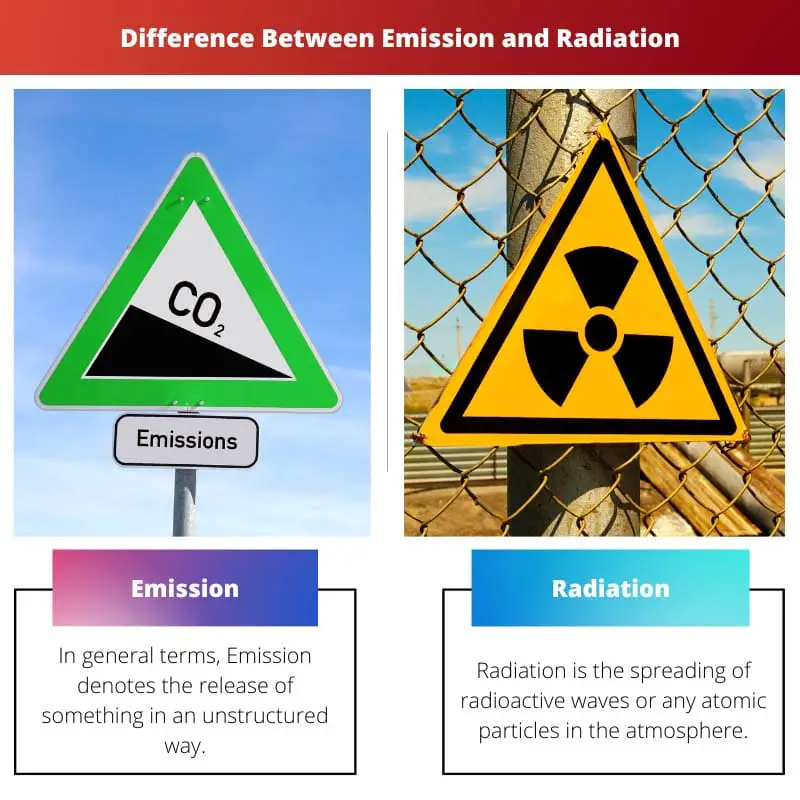Emission and Radiation are the two Physics terminology majority used in space science but they are also a part of our daily life.
Sun is the source of heat energy that we receive throughout the day by the medium of Radiation, and the Emissions of oxygen gas from trees give us life every day.
These are two steps of the energy distribution process in our surroundings.
Key Takeaways
- Emission is the process by which a substance releases energy through electromagnetic waves or particles, while radiation is energy as it travels through space or matter.
- Emissions can result from various processes, such as chemical reactions, nuclear decay, or temperature changes, whereas radiation can take the form of electromagnetic waves or particles.
- Both emission and radiation play critical roles in energy transfer, with applications in astronomy, nuclear energy, and environmental science.
Emission vs Radiation
Emissions refer to releasing pollutants, such as gases or particles, into the atmosphere. These pollutants may come from a variety of sources. Radiation refers to energy emission in the form of waves or particles. Radiation can come from natural sources, such as the Sun, or human-made sources.

Emission is used for an uncontrollable release of any substance in the atmosphere through gas or waves.
It is an act of producing one stored substance in infinite chunks that can be controlled through any preventive measure only. Pollution of petrol smog from motor vehicles is a typical example of Emission.
Radiation is referred to energy distribution in the atmosphere by way of magnetic waves. Radiation is also considered as a medium through which rays travel in-universe.
In some cases, Radiation also travels through substances. Ionized and Non-ionized are the two forms of Radiation to carry energy.
Comparison Table
| Parameters of Comparison | Emission | Radiation |
|---|---|---|
| Meaning | Radiation is the spreading radioactive waves or any atomic particles in the atmosphere. | Emissions can be through the source of Motor Vehicles, Big machinery, or any radioactive substance. |
| Sources | Procedure of Emission is the abnormal supply of some harmful substances. | Radiation can be through the source of a Chemical laboratory or Thunderstorm etc. |
| Procedure | In general terms, Emission denotes the release of something in an unstructured way. | The procedure of Radiation is the Emission of includes Gas Emissionrough an electromagnet object. |
| Types | Several types of Radiation include X-Ray, Alpha, Beta, Gamma Radiation. | Emissions can be controlled through Engine design and Machinery protection shield. |
| Control | Controlling Measures are Distance from the radiation source, Minimal use of electromagnetic devices, and Preventive Sheilds | Controlling Measures are Distance from the radiation source, Minimal use of electromagnetic devices, and Preventive Sheilds. |
What is Emission?
Emission varies from substance to substance, and in layman’s language, it is a unique way of spreading or formation in the atmosphere.
When Emission occurs in chemical compounds in chemistry labs, it is through Gaseous substances.
Gas Emission mostly happens in the case of motor vehicles, generators, plants, and machinery. Apart from a few, leading gases are pollutants in nature that are emitted through the industry.
Some gases are released through manufacturing activity or prominent for pollution emission; Nitrogen, Sulfur-oxide, Volatile organic gas, Carbon monoxide, etc.
Emission of magnetic waves occurs through the following process: The form of Emission is mainly in the state of photons.
The electric field supplies subatomic particles that are elevated through the charge created by an electromagnetic field. The mentioned Emission of atomic particles causes radio frequency movement.
Particles released through the Emission process are namely Alpha, Beta, and Gama. The energy passing through these elements contains very little or Zero mass.
This process of Emission and formation of atomic energy is also used during war situations.
Emission of the spectrum or light spectrum emission contains colours, and the lines of light can be seen without equipment. The emission spectrum is helpful for deriving the composition of any object.

What is Radiation?
Radiation is the term used where specific energy is transported through a channel to form the output. Electromagnetic radiations are useful for diagnosis of X-Ray images to display clear images inside human bodies.
These short wavelengths and gamma rays, if exposed to more than the required limit, can cause harm to nature.
Radiation is ubiquitous in laser surgery of the human body as a tool for operating any human part without any cut or damage. Non-Ionizing Radiation are less harmful in comparison to Ionized Radiation.
Every type of Radiation has some fundamental properties through which the Emission of waves takes place. Radiation medium is very prominent in weather forecasting, television remotes, radars, CT scans, MRI, etc.
Radioactive materials formed through atoms of Radiation are part of our atmosphere. Radiation in our universe is called Cosmic Radiation.
The speed of Radiation is very fast, almost equal to the speed of light from space to Earth. Breaking chemical bonds in the human body affects us in several ways.
Governments use the Radiation process in nuclear reactors. Radiation can move through an object and remains in it for a while.
The quantity of Radiation supplied in an object can be measured through stored particles called absorbed dose.

Main Differences Between Emission and Radiation
- Measured: Emission is measured through dynamometers, and Radiation is measured through Wavelength.
- Effects: Emission of gases affects the lungs and pollutes the environment, whereas Radiation gradually damages the human body like patches on the skin.
- Concept: Emission is the distribution source, whereas Radiation is the medium of distribution for spreading elements.
- Kinds: Emission has 2 types, simultaneous or spontaneous, and Radiation can be ionized or non-ionized.
- Example: Natural release of carbon-di-oxide gas in the night through Trees and Ultra Virus rays from Sun is the example of Emission and Radiation respectively..

- https://aip.scitation.org/doi/abs/10.1063/1.1777371?journalCode=apl
- https://journals.aps.org/pr/abstract/10.1103/PhysRev.140.A1051

This topic is very interesting, I had not made such a big differentiation between both concepts
I felt the same way, it’s so fascinating to think about how these concepts are interwoven into our daily lives.
I think it’s an important text for anyone interested in understanding the universe.
I agree with you, the comparison table was very helpful.